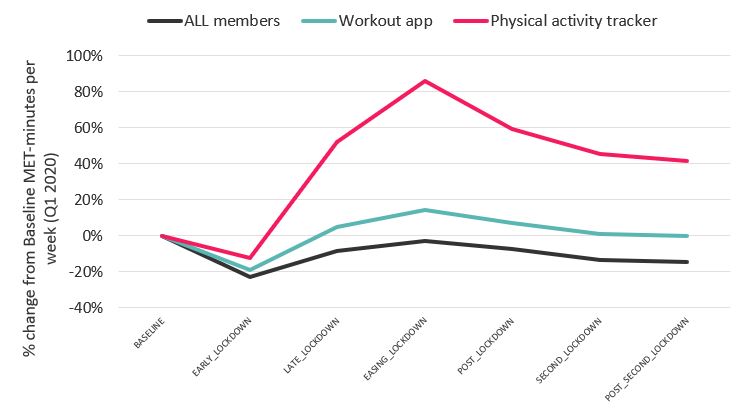Can wearable technology really benefit your client?
As we step into summer, we explore the ways that wearable devices and physical activities can help support the health and wellbeing of you and your clients.
From Apple Watches to Polar, Fitbit and Garmin, today we live during an age in which wearable technology is firmly embedded into fitness culture and a staple in the daily routines of many in the UK.
Research conducted by Clicked earlier this year1 showed that ownership of wearables had doubled in the space of 12 months, with around 12% of the UK population now donning a tracker device of some kind – a figure that equates to approximately six million people.
Findings like these show they can no longer be considered a new or niche product, even though the same research revealed that almost half of UK owners are under 35.
Yes, younger people are most switched-on but that’s slowly changing
A survey conducted in 2019 found that millennials are more likely than members of any other generation in the UK to own a smart watch or health tracker, with 37.6% claiming to own a device2. That aside, the percentage of younger owners is falling, according to the Clicked survey, with the consumer base growing fastest among those over 55, alongside a trend towards increased female interest compared to men.Vitality’s chief medical officer Dr Ali Hasan agreed that “wearables have become very common in our day-to-day lives” in light of a paper published in the Occupational Medicine Journal that he co-authored with VitalityHealth’s managing director Dr Keith Klintworth.
In the article, titled ‘Wearable technology and health improvement’3, they state that wearables sales grew 71% annually in 2019, to 305 million units globally – a number that’s tipped to grow 70% again by 20234.
Recording activity, managing health and nudging change
As the paper points out, interpreting the true potential of wearables can be complicated, perhaps due to challenges observing the effectiveness of a supporting health programme and the varying levels of engagement for those involved with it.Even still, wearables may contribute to an improvement in health for several reasons, the paper explains. These include providing a more reliable record of activity, ensuring more accurate health and activity tracking and being a physical aide to guide habitual change.
They can also help us understand our underlying health and help us manage behaviours, while activity levels are important components of effective health improvement interventions, it explains. ‘Wearables can therefore be a valuable adjunct to support activity level management and improvement’, reads the paper.
“Much of the research we reviewed indicates clear areas of benefit from these devices, in particular to help motivate people to improve and monitor their health,” said Dr Ali Hasan. “It’s also clear that investing in wearables as part of an organisation’s occupational health strategy is likely to be a low-risk approach which may offer many benefits, particularly as the shape of the workplace continues to evolve.”
Members with a tracking device recorded higher levels of physical activity during the pandemic
According to the Active Lives survey by Sport England5, the first three months of the COVID-19 pandemic resulted in just over three million fewer active adults, as the percentage of those doing over 150 minutes of exercise a week fell by 7.1% to 58.2%.The survey findings are reflected by our data. Looking at daily activity by more than 330,000 Vitality members who tracked their physical activity between 6 January 2020 and 3 January 2021, physical activity levels fell as the pandemic restrictions took place (as the graph below shows).

Interestingly, this surge in physical activity levels runs parallel with our Covid response after we saw a widespread reduction in steps, which led us to introduce Vitality at Home benefits in April 2020 and further expand then into a Winter Pack in October. These ventures offered members access to workout apps and discounts on activity trackers to encourage members to work-out at home. These incentives alongside a range of factors appear to have helped Vitality members get more active during lockdown.
For members who took up a Vitality at Home benefit in April 2020, we did not see a reduction in physical activity – instead, their levels increased by an average of 25% from their baseline by the time lockdown was eased in June 2020. This equates to an extra 37 minutes of moderate intensity cardio per week or 18 minutes of vigorous intensity cardio per week7.
On top of this, those who took out a physical activity tracker between March and April 2020 also maintained higher levels of physical activity throughout the pandemic, with physical activity levels sitting at 59% (post-lockdown), 45% (second lockdown) and 41% (after restrictions eased again) over the baseline respectively.
Tracking devices are not just for fitness, they can help monitor health conditions too
The role that wearable devices can have when monitoring health conditions is brought to life by James’s story, recently published in Vitality Magazine. As a Vitality member, he acquired an Apple Watch to support him in tracking his health and fitness levels. In the same year, he suddenly fainted, hit his head and, after going to the doctors and his local hospital, found out that he suffered from hypertrophic cardiomyopathy - a potentially life-threatening heart condition. As a result, the value of his device in monitoring and tracking his heartbeat over time really came into its own.James said: “Since my diagnosis, having an Apple Watch has really given me peace of mind, as it allows me to monitor my condition on a daily basis. Last year, my watch helped me to seek medical help when it alerted me to changes in my heart rate on a number of occasions. The watch has also encouraged me to get outside, get more active and track my steps every day.”
"Last year, my watch helped me to seek medical help when it alerted me to changes in my heart rate on a number of occasions. The watch has also encouraged me to get outside, get more active and track my steps every day.”
Sources:
1. https://www.prfire.com/submission/uk-study-highlights-key-trends-in-wearables
2. https://www.statista.com/statistics/1044033/uk-smartwatch-health-trackert-ownership/
3. Wearable technology and health improvement, Occupational Medicine Journal, 2021
4. IDC Corporate USA. Worldwide Wearables Market to Top 300 Million Units in 2019 and Nearly 500 Million Units in 2023, Says IDC
5. Active Lives Adult Survey Coronavirus (Covid-19)
6. A set period in which our Garmin and Polar 50% discount ran
7. Vitality member data – those who registered for a workout app or bought a device in April 2020
Where to next?
-
What's the cost of not living a healthy lifestyle?
How significant is the impact of serious illness on COVID-19 complications and can a behaviour change programme like Vitality help members reduce their risk?
-
Activity Tracking
Your clients can get savings on a wide range of activity trackers and see the rewards add up.
-
Insights Hub
Our Insights Hub brings you our range of adviser content - from video series to articles & blogs.

